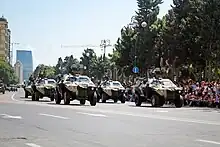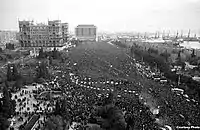Azadliq Square, Baku
Azadliq Square (Azerbaijani: Azadlıq meydanı), in Baku is the biggest city-centre square in Azerbaijan. It lies next to Baku Boulevard.
| Native name | Azadlıq meydanı (Azerbaijani) |
|---|---|
| Former name(s) | Lenin Square |
| Type | Public square |
| Maintained by | Mayoralty of Baku |
| Location | Baku, Azerbaijan |
| Coordinates | 40°22′21″N 49°51′12″E |
| Construction | |
| Construction start | 1960–70s |
History

The square, formerly named Lenin Square after Vladimir Lenin, was created in the 1960–70s, after construction of the Government House of Baku was finished in 1952. A monument to Lenin was erected in 1955.[1] It was also formerly known as Stalin Square. Along with the square, Baku authorities constructed several buildings including the "Azerbaijan" and "Absheron" hotels encircling the square, which were later demolished and replaced with the Hilton Baku and the JW Marriott Absheron Baku Hotel. The Lenin monument sculpted by D. M. Garyaghdi was removed in the early 1990s.[2] The square was renamed Azadliq Square (Freedom Square) in 1991 after the collapse of the Soviet Union.[3] In 2006, a government-sponsored project oversaw renovation works at Government House and its vicinity including Azadliq Square. Works lasted until 2010.[4]
Buildings and structures
- Government House
- Baku Boulevard, across the Neftchiler Avenue
- JW Marriott Absheron Baku Hotel
- Hilton Baku
Gallery
 The construction of Government House in the 1930s.
The construction of Government House in the 1930s.
Events
Parades

During the Cold War, Lenin Square was used as a parade ground for the annual International Workers' Day demonstration on May 1, as well as the Victory Day and October Revolution Day military parades on May 9 and November 7 respectively. Azadliq Square is the main venue for the bi-annual Day of the Armed Forces military parade which takes place on June 26.[5] In 2018, the square was used as the main venue for the centennial celebrations of the Battle of Baku, which was attended by Presidents Ilham Aliyev and Recep Tayyip Erdogan.[6][7] On 10 December 2020, a victory parade took place on Azadliq Square, honouring the Azerbaijani victory during the 2020 Nagorno-Karabakh war,[8] during which Armenian war trophies and Azerbaijani military vehicles,[9] were displayed.
Demonstrations
Starting on 17 November 1988, large-scale demonstrations began in Baku's Lenin Square to protest against the alleged destruction of a forest near Shusha by Armenians.[10] As the demonstrations continued, they became increasingly anti-Armenian, with chants of "death to the Armenians"[11] and demands that those convicted of the murder of Armenians during the Sumgait pogrom be released. The demonstrations also developed into an anti-central government, anti-Soviet protest. On 23 November, a curfew was imposed in Baku and Soviet troops tried unsuccessfully to disperse the crowds. The events later led to the proclamation, in 1992, of National Revival Day of 17 November. Following the Black January crackdown by Soviet troops in Baku on 20 January 1990, Azadliq Square became the gathering and mourning place for approximately 2 million people who gathered to take the dead to a burial site in Martyrs' Lane in upper Baku.
Protests during the 2003 Azerbaijani protests took place on the square.[12]
Other
In 1989 one of Azerbaijan's greatest vocalists, Yaqub Zourofchi, held a revolutionary concert as Azerbaijan was gaining their independence from USSR. The square was used for the Baku City Circuit.[13]
References
- "Memarliq-Döqüzinci Bölüm (Architecture-7th chapter)". Archived from the original on October 11, 2008. Retrieved August 18, 2010.
- "Илюстрация "Руднев Л. В., Мунц В. О. Дом правительства (Баку)" в Большой Советской Энциклопедии". Archived from the original on January 26, 2018. Retrieved August 18, 2010.
- Старые наименования улиц и площадей Баку. Archived 2019-12-08 at the Wayback Machine (in Russian)
- "Reconstruction of Government House in Baku cost $40 million". Archived from the original on July 6, 2011. Retrieved August 18, 2010.
- Holding, APA Information Agency, APA. "Military parade held in Azerbaijan". Archived from the original on 2018-05-18. Retrieved 2017-05-05.
{{cite news}}: CS1 maint: multiple names: authors list (link) - "Azerbaijan: Military parade planned in Baku September 15". Archived from the original on 2018-09-16. Retrieved 2018-09-16.
- "100th anniversary of Baku's liberation marked in Azerbaijan". Archived from the original on 2018-09-15. Retrieved 2018-09-16.
- "Baku preparing for grandiose Victory Parade – VIDEO". Azerbaycan24. 3 December 2020. Archived from the original on 7 January 2021. Retrieved 10 December 2020.
- Makarenko, Alena (2 December 2020). "Эрдоган приедет на парад победы в Баку: мнение политолога date". 360 TV (in Russian). Archived from the original on 8 January 2021. Retrieved 10 December 2020.
- Stuart J. Kaufman,Modern Hatreds: The Symbolic Politics of Ethnic War p.66.
- Mark Malkasian, Gha-ra-bagh!: The Emergence of the National Democratic Movement in Armenia, p170. Wayne State University Press, 1996.
- "Алиев заявил, что некоторые страны разрабатывали план по его свержению". РИА Новости (in Russian). 2021-04-12. Archived from the original on 2021-04-17. Retrieved 2021-04-17.
- Азад Рагимов рассказал о примерной трассе бакинского этапа Формулы-1 [Azad Ragimov told about approximate track of Baku Formula 1 race]. www.azerisport.com (in Russian). Archived from the original on 29 July 2014. Retrieved 25 July 2014.